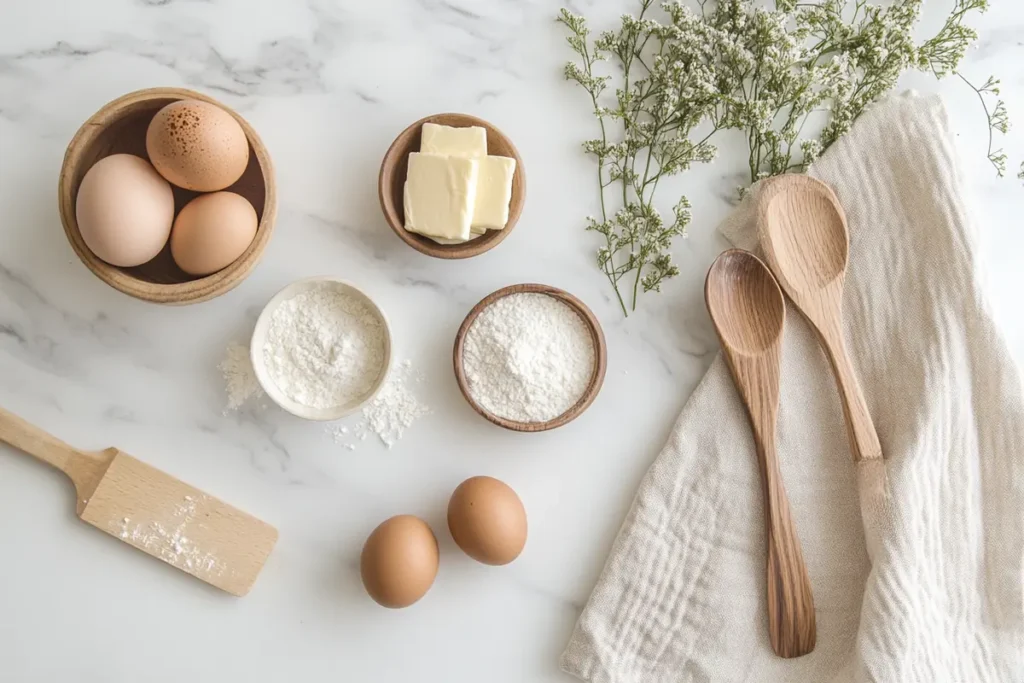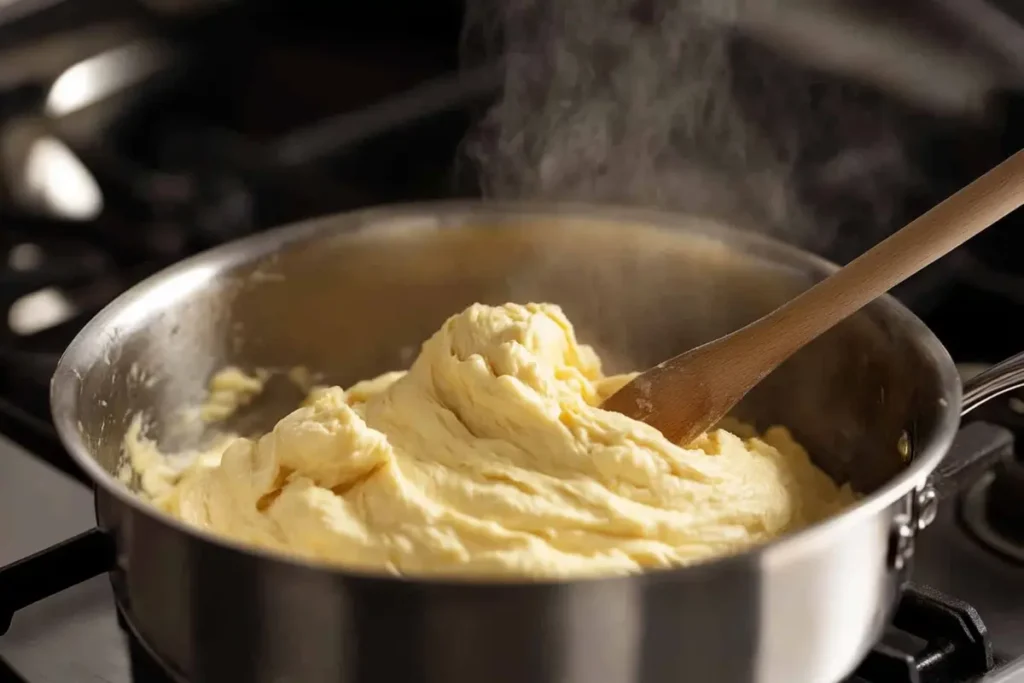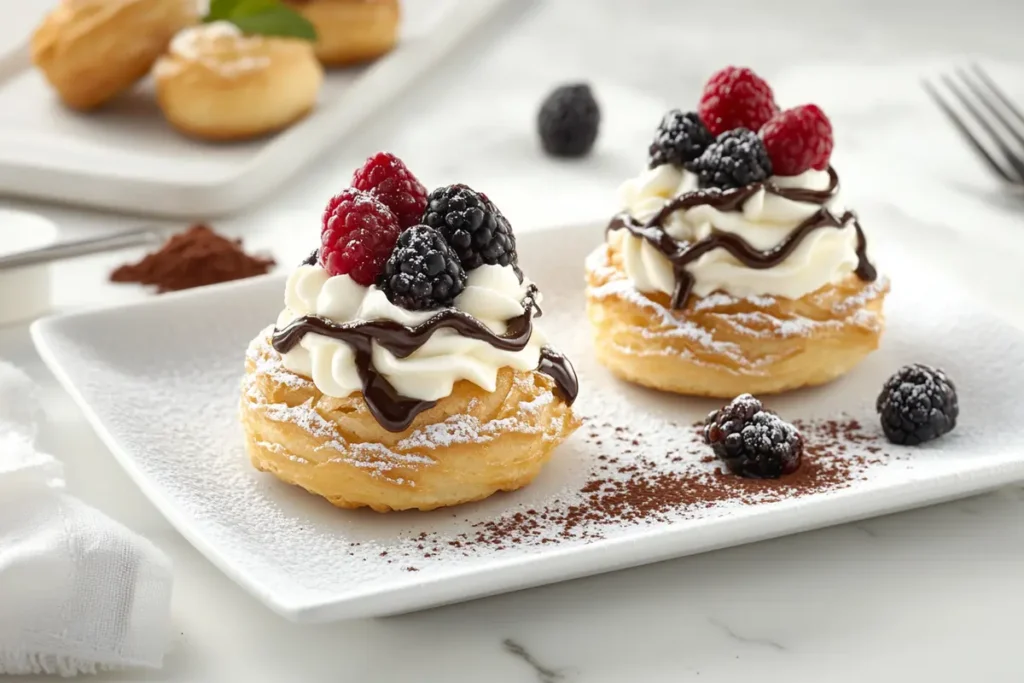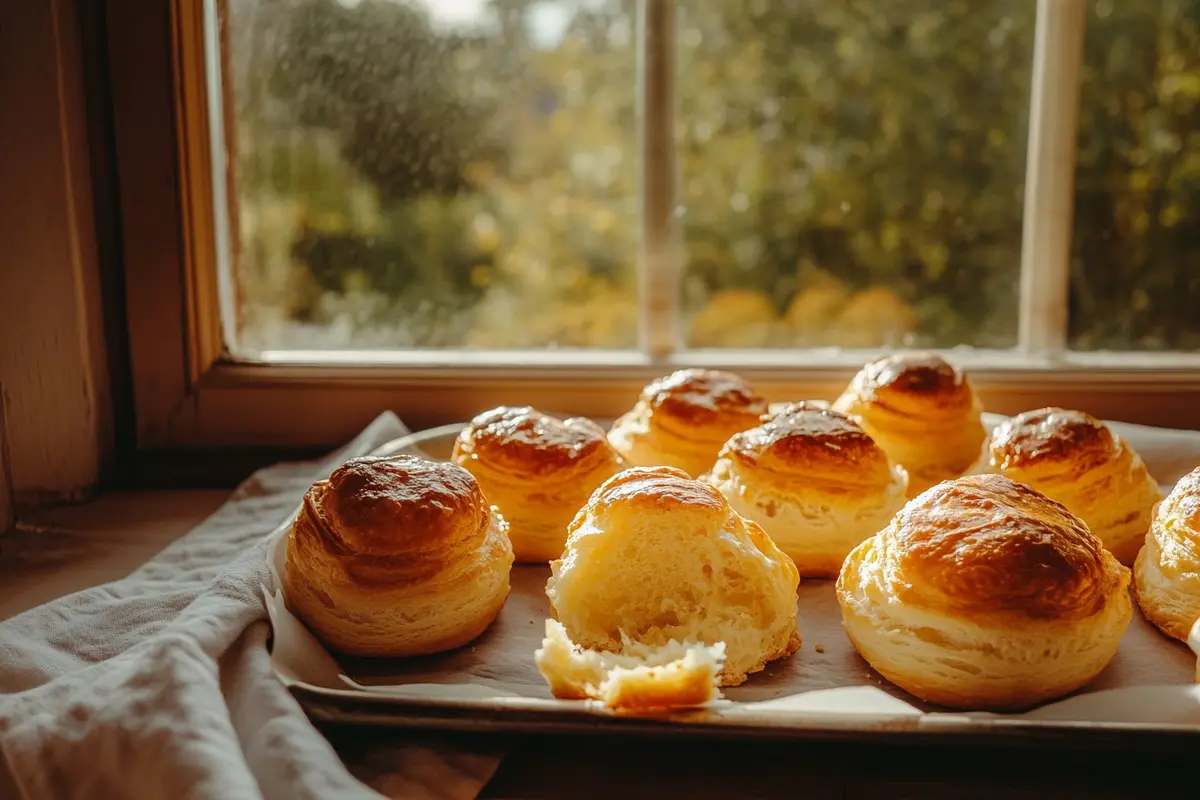Understanding Choux Pastry
Choux pastry, or pâte à choux, is a classic French pastry dough that’s unlike any other. Unlike typical doughs that rely on baking powder or yeast for leavening, choux pastry magically puffs up in the oven through the power of steam. That’s right—steam is the secret ingredient here, giving this pastry its airy interior and crisp golden crust. Used to make some of the most iconic French desserts, choux pastry is famous for its versatility and elegant simplicity.
The name “choux” actually means “cabbage” in French, a nod to the dough’s resemblance to small cabbage heads when piped and baked. And while it may look fancy, the beauty of choux pastry lies in its humble beginnings—it’s made from basic pantry staples that, when handled correctly, transform into something extraordinary.
Why Technique Matters in Choux Pastry
When it comes to choux pastry, the devil’s in the details. This dough isn’t like cookie dough or cake batter, where a bit of improvisation may go unnoticed. Every step of the process—from cooking the panade (the flour, butter, and water mixture) to incorporating eggs—affects the final outcome.
For example, if the dough is too wet, the pastry won’t rise; if it’s too dry, it won’t puff up properly. And baking? That’s a whole other story. Without the right temperature and moisture, those beautiful puffs might collapse like a house of cards.
The Origins
The history of choux pastry is as fascinating as the pastries themselves. Dating back to the 16th century, it was initially developed by an Italian chef named Pantanelli, who worked for Catherine de’ Medici. Over time, French chefs refined the recipe, adding their flair and making it the sophisticated dough we know today. Its versatility has made it a cornerstone of French patisserie, with creations like éclairs, profiteroles, and the intricate Paris-Brest wowing food lovers worldwide.
The Key Characteristics of Choux Pastry
What makes choux pastry truly unique is its texture and structure. When baked to perfection, choux pastry has:
- A light and hollow interior: Perfect for fillings like cream or custard.
- A golden, crisp exterior: This shell is sturdy enough to hold its shape but delicate enough to crumble slightly with every bite.
- An airy, melt-in-your-mouth feel: The result of steam escaping during baking, leaving behind air pockets.
Understanding these characteristics is the first step to mastering this iconic pastry. Once you know what you’re aiming for, the secrets behind achieving it become clearer.
Essential Ingredients

One of the beauties of choux pastry is its simplicity. It uses just a handful of ingredients, but each plays a crucial role in the final product:
- Flour: This is the backbone of the pastry. All-purpose flour or bread flour works best because their higher protein content gives the pastry structure.
- Butter: Adds richness and flavor while helping to form the dough during the cooking stage.
- Water (or Milk): Provides the liquid needed for steam and hydrates the flour. Water is most commonly used for a crisper shell, while milk adds a touch of richness.
- Eggs: Perhaps the most important ingredient, eggs are responsible for the dough’s elasticity and its ability to rise. They also add richness and color to the final product.
Each ingredient is essential—mess with the ratios, and you might end up with a dough that’s too dense or too thin. For instance, using too many eggs can make the dough overly runny, while too little fat from butter might prevent the dough from forming properly.
Steam: The Real Secret to Choux Pastry’s Puff
While the ingredients are critical, the true magic of choux pastry lies in the steam. When the dough hits the high heat of the oven, the water inside turns into steam, causing the dough to expand and puff up. This process creates the hollow centers that are perfect for fillings. Without enough moisture in the dough—or if your oven isn’t properly preheated—the steam won’t work its magic, and your pastry may fall flat.
Secrets to Perfect Choux Pastry
The Secret Techniques
The key to unlocking the secret of perfect choux pastry lies in the method. While the ingredients are straightforward, it’s the technique that transforms them into those delicate, airy puffs we all adore. Below, we’ll break down the critical steps to success.
The Perfect Panade: Building the Foundation

Choux pastry begins with a cooked dough known as the panade. This step is where many bakers stumble, but nailing it is essential. To make the perfect panade:
- Cook the mixture thoroughly: Combine water, butter, and a pinch of salt in a saucepan and heat until the butter is fully melted. Once the mixture comes to a boil, add the flour all at once and stir vigorously.
- Keep stirring: You’ll notice the dough coming together into a smooth, shiny ball. This process not only cooks the flour but also helps evaporate excess moisture, which is critical for achieving the right texture later.
- Look for the right consistency: The dough should pull away from the sides of the pan and leave a thin film on the bottom. This ensures the flour has been properly cooked.
Skipping or rushing this stage can lead to undercooked dough, which will prevent the pastry from rising properly, as seen in this mini cream puffs recipe. It’s better to err on the side of caution and stir for an extra minute or two.
Incorporating Eggs Gradually: Achieving the Right Texture
After cooking the panade, the next step is adding eggs. This stage is where choux pastry takes on its characteristic elasticity and puffing power. However, adding eggs requires a careful, methodical approach:
- Cool the panade slightly: If you add eggs to hot dough, they’ll scramble—yikes! Allow the dough to cool for a few minutes before proceeding.
- Add eggs one at a time: Crack each egg into the dough, mixing thoroughly before adding the next. This ensures even distribution and prevents the dough from becoming too runny.
- Look for the ribbon effect: The dough is ready when it’s smooth, glossy, and forms a “V” shape when it falls from a spoon. If the dough is too stiff, your pastry won’t rise; if it’s too loose, it will spread too much in the oven.
Pro Tip: You might not need all the eggs the recipe calls for. The amount depends on factors like humidity and the exact consistency of your panade. Trust your instincts (and your eyes) here!
Baking Tips for Choux Pastry Success
Once the dough is ready, the next challenge is baking. This is where choux pastry truly transforms, and getting it right requires attention to detail.
Preheat the Oven Properly
A hot oven is non-negotiable. Preheating ensures that the choux pastry puffs up immediately when exposed to high heat. For most recipes, 375–400°F (190–200°C) works best.
Avoid Opening the Oven Door
Patience is key! Opening the oven door during baking can cause the temperature to drop, leading to collapsed puffs. If you’re tempted to peek, resist! Let the magic happen undisturbed.
Use Steam for Better Rise
Here’s a pro-level trick: Introduce steam into the oven. Steam helps create a moist environment that prevents the pastry from forming a crust too quickly, allowing it to rise properly. You can do this by:
- Placing a pan of hot water on the oven floor
- Spritzing the inside of the oven with water just before baking
Proper Cooling Techniques
Once the pastries are golden and puffed, you might think the hard work is over—but wait! Cooling choux pastry correctly is just as important as baking it.
- Pierce the puffs: To prevent sogginess, poke a small hole in each puff as soon as they come out of the oven. This allows steam to escape.
- Cool completely: Let the pastries cool on a wire rack to maintain their crispness.
Troubleshooting Common Choux Pastry Problems
Even the best bakers encounter hiccups when making choux pastry. Here’s how to address some of the most common issues:
Why Did My Choux Pastry Collapse?
Collapsed pastry is often caused by underbaking. If the interior isn’t fully set, the pastry won’t be able to hold its shape once it cools. Always bake until the puffs are deeply golden and feel dry to the touch.
Why Is My Choux Pastry Dough Too Runny or Too Thick?
The most likely culprit here is the ratio of eggs to panade. If the dough is too runny, you may have added too many eggs or skipped the crucial step of cooking off moisture in the panade. Conversely, if it’s too thick, you may need to incorporate an additional egg to loosen it up.
Why Are My Puffs Soggy or Undercooked?
Sogginess often comes from insufficient baking or a lack of steam release. Remember to pierce the pastries after baking to let any trapped moisture escape. Additionally, ensure your oven temperature is accurate—an oven thermometer can be a baker’s best friend.
The Role of Practice in Perfecting Choux Pastry
As with any skill, practice makes perfect. The more you make choux pastry, the more intuitive the process will become. Each attempt teaches you something new, whether it’s how to recognize the perfect dough consistency or how to time your baking for the ultimate puff. Don’t be afraid to experiment—mistakes are part of the journey!
Advanced Choux Pastry Techniques
Creative Variations
Once you’ve mastered the basics of choux pastry, a whole new world of possibilities opens up. From flavored dough to stunning presentations, advanced techniques let you take this humble pastry dough to the next level. Let’s explore some creative ways to elevate your choux game.
Adding Flavors to Choux Dough
While traditional choux pastry is subtly flavored to allow its fillings to shine, there’s no reason you can’t infuse your dough with exciting flavors to complement your creation. Here are a few ways to do just that:
- Herbs and Spices: For savory choux pastries like gougères, try adding herbs like thyme, chives, or even a pinch of nutmeg to the dough.
- Cheese: Aged cheeses like Gruyère or Parmesan can be folded into the dough for a rich, salty kick. This transforms your choux into gougères—a popular French appetizer.
- Citrus Zest: Add a bright, zesty flavor to your desserts by incorporating lemon, lime, or orange zest into the dough.
- Vanilla or Cocoa Powder: For sweet applications, vanilla bean paste or a touch of cocoa powder can subtly flavor the pastry itself.
Adding flavors should be done sparingly to avoid disrupting the dough’s consistency. A little goes a long way!
Transforming Choux Pastry into Iconic Desserts
Choux pastry isn’t just a single dish—it’s a foundation for a variety of famous desserts and savory treats. Some of the most well-loved creations include:
- Éclairs: These long, slender pastries are filled with pastry cream and often topped with chocolate glaze. They’re a staple of French patisseries and a great way to showcase your choux pastry skills.
- Profiteroles: Small, round choux puffs that are typically filled with whipped cream, custard, or ice cream and drizzled with chocolate sauce. They’re as versatile as they are delicious!
- Paris-Brest: This elegant dessert features a ring of choux pastry filled with praline cream. It’s named after a bicycle race between Paris and Brest, with its circular shape symbolizing a wheel.
- Religieuses: These are essentially two profiteroles stacked on top of each other, filled with cream, and decorated with icing. They resemble a nun’s habit, hence the name “religieuses.”
Each variation uses the same core dough but showcases its versatility in different shapes, fillings, and finishes.
Decorating and Filling Your Choux Pastry
Choux pastry is like a blank canvas waiting to be adorned with delicious fillings and dazzling decorations. Here’s how you can make your choux pastry creations even more eye-catching and scrumptious:
Choosing the Right Filling
The hollow interior of choux pastry is perfect for holding a variety of sweet and savory fillings. Some classic options include:
- Pastry Cream: A rich and creamy custard flavored with vanilla, chocolate, or coffee is a timeless choice for éclairs and cream puffs.
- Whipped Cream or Chantilly Cream: Light and fluffy, whipped cream adds an airy contrast to the crisp pastry. Add a touch of powdered sugar and vanilla for extra flavor.
- Cheese or Herb Filling: For savory gougères, pipe in a soft cheese mixture or a herbed cream cheese for a delightful appetizer.
- Ganache or ice cream fillings are indulgent choices for profiteroles, as shown in this guide on how to caramelize brûlée. with rich chocolate ganache or a scoop of ice cream.
When filling choux pastry, use a piping bag fitted with a small tip. Insert it into the base or side of the pastry and gently fill until the pastry feels slightly heavy in your hand. Be careful not to overfill, as it can cause the pastry to lose its structure.
Glazing and Toppings
Once filled, choux pastry can be finished with glazes and toppings to enhance both its flavor and presentation. Some options include:
- Classic Glazes: A thin layer of chocolate, caramel, or fondant glaze adds a glossy finish and extra sweetness.
- Powdered Sugar Dusting: For a more understated look, a light dusting of powdered sugar is simple yet elegant.
- Crunchy Craquelin: This is a crumbly, cookie-like dough that’s placed on top of the choux before baking. As the pastry bakes, the craquelin forms a beautiful crackled topping that adds a sweet crunch.
- Chopped Nuts or Sprinkles: Garnish the top of your pastries with finely chopped nuts, sprinkles, or even edible flowers for an artistic touch.
Pro Tip: Always glaze or top your pastries just before serving to ensure they stay fresh and crisp. Too much moisture from glazes can cause the pastry to lose its signature crunch.
Tips for Presentation
When serving choux pastry, presentation is everything! Here are some tips to make your creations look as stunning as they taste:
- Use Uniform Piping: To achieve professional-looking results, use a piping bag with a round or star tip for consistent shapes.
- Stack or Arrange Creatively: For desserts like croquembouche (a tower of cream puffs held together with caramel), stack your pastries artfully to wow your guests.
- Color Coordination: Match the colors of your fillings and glazes for a cohesive and visually appealing dessert.
Troubleshooting Choux Pastry and Perfecting the Craft
Common Choux Pastry Problems and How to Fix Them
Even with the best recipes and preparation, choux pastry can be finicky. Understanding why things go wrong and how to fix them is crucial for becoming a confident choux pastry baker. Let’s address some of the most common issues and their solutions.
Why Isn’t My Choux Pastry Rising?
One of the most frustrating problems is flat choux pastry. A lack of rise can occur for several reasons:
- Insufficient Heat: If your oven isn’t hot enough, the steam needed to puff the pastry won’t form. Preheat your oven to at least 375°F (190°C) and avoid opening the door during baking.
- Incorrect Dough Consistency: Dough that’s too wet or too dry can prevent proper rising. Use the “V test” (the dough falling off the spoon in a ribbon shape) to ensure the right consistency.
- Underbaked Pastry: If the pastry isn’t baked long enough, it won’t hold its shape. Bake until golden and dry to the touch.
Why Does My Choux Pastry Collapse After Baking?
Nothing’s more disheartening than beautifully puffed choux that deflates the moment it’s out of the oven. This happens because the structure of the pastry isn’t strong enough to hold its shape.
- The Fix: Bake your pastry a bit longer to ensure it’s fully set. You can also poke a small hole in each puff as soon as they come out of the oven to release steam and prevent sogginess.
Why Is My Choux Pastry Too Thick or Too Runny?
Consistency is everything in choux pastry, and adding too many or too few eggs can quickly throw things off.
- Runny Dough: If your dough is too runny, it means you’ve added too much egg. Unfortunately, there’s no way to remove eggs once they’re added, but you can salvage the batch by making a new panade (the cooked flour mixture) and mixing it with the runny dough to adjust the consistency.
- Thick Dough: Dough that’s too thick can result from undercooking the panade or not adding enough egg. Whisk an additional egg separately, and add it gradually until the dough loosens to the desired texture.
Why Are My Puffs Soggy Inside?
Soggy interiors usually mean the pastry is undercooked or hasn’t been properly dried after baking.
- The Fix: Extend the baking time slightly, and make sure to pierce each puff with a small hole to allow steam to escape. Cooling them on a wire rack also helps retain crispness.
Pro-Level Choux Pastry Tips
Mastering choux pastry doesn’t happen overnight, but with these expert tips, you’ll be one step closer to perfection:
Measure Your Ingredients Carefully
Precision is everything in baking, and choux pastry is no exception. Use a kitchen scale to measure your ingredients by weight rather than volume for the most accurate results.
Test for Consistency at Every Step
At each stage—cooking the panade, adding eggs, and piping the dough—check the consistency. The dough should be smooth, glossy, and elastic.
Invest in Quality Tools
The right tools can make a world of difference. A sturdy piping bag with a variety of tips is essential for shaping your choux pastry. A silicone baking mat or parchment paper ensures even baking and easy cleanup.
Practice Piping Skills
Uniformity is key for professional-looking choux pastry. Practice piping consistently sized rounds or éclairs on parchment paper before baking. A template under the paper can help guide you.
Experiment with Fillings and Toppings
Once you’ve got the basics down, have fun experimenting! Try seasonal fruit fillings, unique flavored glazes, or savory variations. The possibilities are endless.
The Importance of Patience in Mastering Choux Pastry
Choux pastry is equal parts art and science, and it rewards bakers who take the time to practice and refine their techniques. Don’t be discouraged if your first few attempts don’t turn out perfectly. Each batch will teach you something new, and with time, you’ll develop an intuitive understanding of the process.

Frequently Asked Questions
Why Isn’t My Choux Pastry Rising?
There are a few common reasons why choux pastry doesn’t rise. Insufficient heat in the oven is the main culprit, as the steam required for puffing won’t develop without a hot environment. Another reason could be the dough consistency—if it’s too wet or too dry, the pastry won’t expand properly. Always ensure your oven is preheated, and test your dough for the correct consistency before baking.
How Long Can I Store Choux Pastry?
Choux pastry is best enjoyed fresh for its crisp texture. However, unfilled choux pastry can be stored in an airtight container at room temperature for up to 24 hours. If you’d like to keep it longer, freeze the baked pastry for up to 1 month, then reheat it in the oven to restore its crispness before filling. Filled choux pastries should be consumed within a few hours to avoid sogginess.
Can I Make Choux Pastry Dough Ahead of Time?
Yes, choux pastry dough can be made ahead of time. After preparing the dough, store it in an airtight container in the refrigerator for up to 24 hours. When you’re ready to bake, allow the dough to return to room temperature and pipe it directly onto your baking sheet. Keep in mind that freshly made dough will yield the best rise.
Why Is My Choux Pastry Hollow?
A hollow interior is exactly what you want in choux pastry! This makes it perfect for holding fillings like pastry cream or whipped cream. If your pastry is collapsing or too hollow, though, it may not have been baked long enough or cooled properly. Always bake until golden brown and allow steam to escape after baking.
Conclusion
Choux pastry may have a reputation for being tricky, but with the right techniques, a dash of patience, and a willingness to experiment, it’s a skill that anyone can master. From achieving the perfect dough consistency to troubleshooting common issues, understanding the process is key to creating light, airy, and beautifully golden puffs every time.
Remember, the secret to choux pastry lies in precision—carefully measuring your ingredients, watching your dough for the ideal texture, and controlling your oven environment. But beyond the technicalities, choux pastry is a blank canvas for creativity, offering endless possibilities for both sweet and savory treats.
Whether you’re baking éclairs, profiteroles, or a Paris-Brest, the journey to perfecting choux pastry is as rewarding as the delicious results. So, roll up your sleeves, grab your piping bag, and get baking! Your perfect puff is just a few tries away.

